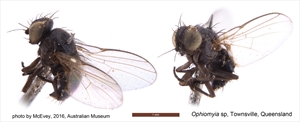Bean fly
Pacific Pests, Pathogens and Weeds - Online edition
Pacific Pests, Pathogens & Weeds
Bean (cowpea) fly (291)
Ophiomyia phaseoli; previously Melanagromyza phaseoli.
Asia, Africa, North America (Hawaii), Oceania. It is recorded from Australia, Fiji, Guam, Federated States of Micronesia, Northern Mariana Islands, Palau, Papua New Guinea, Samoa, and Solomon Islands.
Navy beans (or haricot bean), a type of the common bean, Phaseolus vulgaris, native to the Americas; adzuki beans (Vigna angularis), cowpea (Vigna unguiculata), and mung bean (Vigna radiata), and many other members of the legume (Fabaceae family) are also minor hosts. Its name 'navy' comes from its use as a ration in the US navy in the 19th century. Soybean (Glycine max) is not an important host. The weed, phasey bean (Macroptilium lathyroides), is a host.
Both the adults and the larvae cause damage, mostly on seedlings in the first 3-4 weeks after emergence. The adults make holes in the young leaves as they feed and lay eggs. The larvae or maggots mine the leaves, then tunnel through the leaf stalks and stems moving to the base of the plant to pupate. Older plants show weak growth, and the leaves attacked at an earlier stage hang down, and may dry out and fall. Swellings may occur at the junction of stem and root, and this causes cracks which may lead to stunting and death (Photo 1).
Eggs are white, oval, laid near the leaf stalks of the tender young leaves, especially in the first ones with a single leaflet, but also in the next two with three leaflets. The eggs hatch, and the maggots grow to about 3 mm. There are three stages over about 10 days, and then the maggots pupate; this occurs at the stem/root junction (or in older plants at the junction of leaf blade and leaf stalk). Pupation lasts about 10-12 days depending on temperature. The adults are shiny black flies, 2 mm long, with clear wings, about 5 mm wide (Photos 2&3).
Damage is greatest in young plants, and during dry times. Reduced crop yields are reported from Africa and Asia as well as Australia; in some instances, seedlings are killed, or plants are stunted and fail to produce pods, and yield losses are high.
Look for tunnels at the base of the leaf blades, and in the stems. The larval tunnels (or mines) are better seen on the underside of the leaves, at first silvery, later brown. Look for pupae in the lower stems, at the junction with the root. If bean fly is suspected, cut the stem open and look for dark areas just under the surface, and look for larvae and pupae. Monitor for damage at 2-3 leaf stage, and if 3-5 dying plants are found caused by maggot tunneling, or 3-4 adults per m2, then consider chemical control.
NATURAL ENEMIES
There are many natural enemies of Ophiomyia of which Opius species (braconid wasp larva parasitoids) are the most common in both Asia and Africa. Two species, Opius phaseoli and Opius importatus, were introduced into Hawaii in 1969 from East Africa, but occasional outbreaks of bean fly still occur.
CULTURAL CONTROL
Before planting:
- Remove volunteer plants and weeds, especially those in the legume family, e.g., phasey bean.
- Do not plant beans next to older crops of the same type or to other types in the same (legume) family; leave as much distance as possible.
During growth:
- Hill-up 2-3 weeks after germination to cover roots which are stimulated to grow on plants damaged by the bean fly.
- Mulch with, e.g., banana leaves or grass to encourage root formation.
After harvest:
- Collect and burn or bury as much of the crop as possible.
RESISTANT VARIETIES
Breeding has been attempted at the AVRDC (World Vegetable Center, Taiwan), and also at CIAT, Colombia, so check whether tolerant varieties are available in your country.
CHEMICAL CONTROL
Where infestations are severe, insecticides should be considered for the control of bean fly. However, the larvae which do the damage are well protected inside the plants. Several products are registered for use in Australia, but they are considered 'hazardous' and should be used with care. Commonly used are dimethoate, which is systemic (group 1B highly hazardous), and the contact insecticides, diazinon (group 1B highly hazardous) and methomyl (group 1A extremely hazardous). Seedlings are treated about 3-4 days after emergence and, if bean fly infestations are severe, repeated at 7 days, and possibly at 14 days.
It is likely that a seed dressing with imidacloprid would be effective.
Note, these insecticides are not sold for household use in many countries because of their toxicity, but registered for commercial use only.
____________________
When using a pesticide, always wear protective clothing and follow the instructions on the product label, such as dosage, timing of application, and pre-harvest interval. Recommendations will vary with the crop and system of cultivation. Expert advice on the most appropriate pesticides to use should always be sought from local agricultural authorities.
AUTHOR Grahame Jackson
Information from CABI (2015) Ophiomyia phaseoli (bean fly). Crop Protection Compendium (https://www.cabi.org/cpc/datasheet/33002); and from DAF (2018) Bean fly. Business Queensland. Queensland Government. (https://www.business.qld.gov.au/industries/farms-fishing-forestry/agriculture/crop-growing/pests-field-crops/bean-fly). Photos 1&2 Shepard M et al. Insects and their natural enemies associated with vegetables and soybean in Southeast Asia, Bugwood.org. Photo 3 Shane McEvey, Australian Museum (Phyiomyia sp., Townsville, Queensland).
Produced with support from the Australian Centre for International Agricultural Research under project PC/2010/090: Strengthening integrated crop management research in the Pacific Islands in support of sustainable intensification of high-value crop production, implemented by the University of Queensland and the Secretariat of the Pacific Community.






